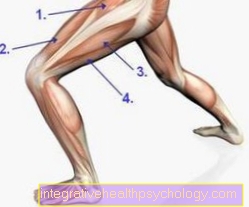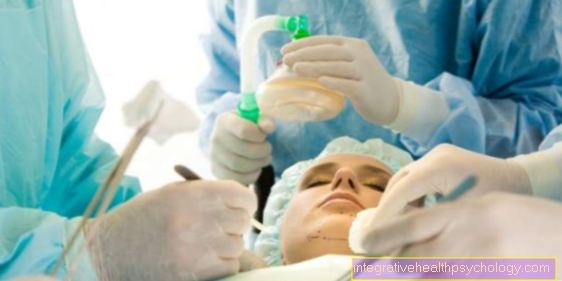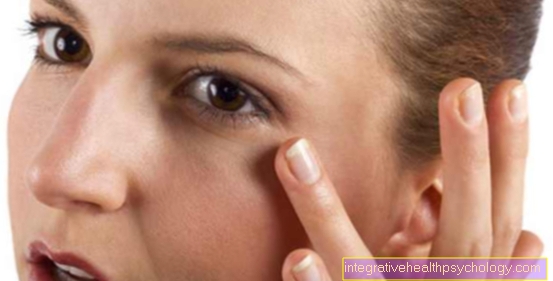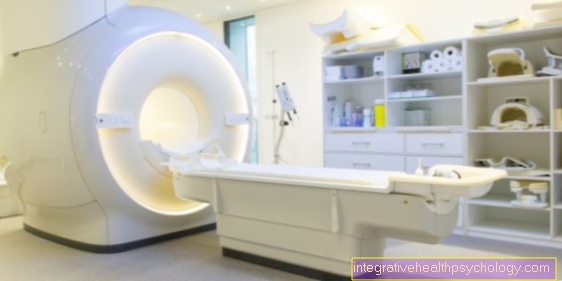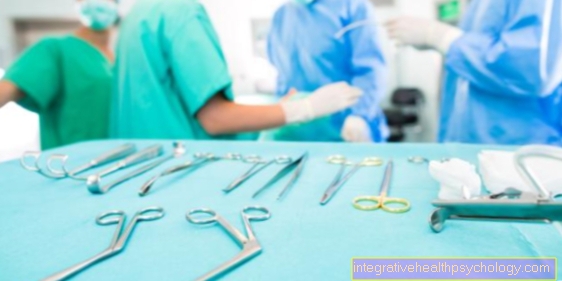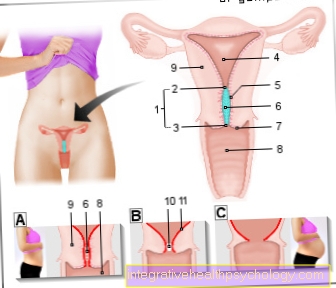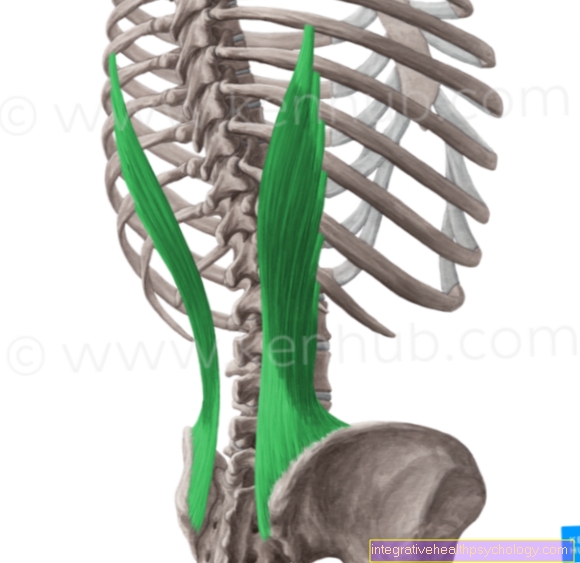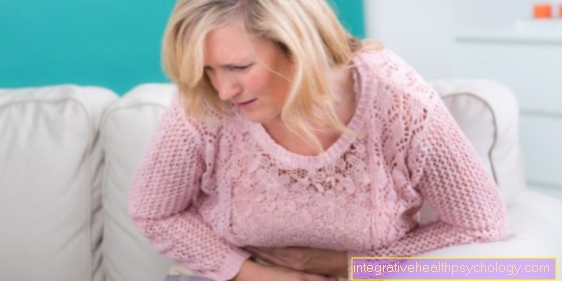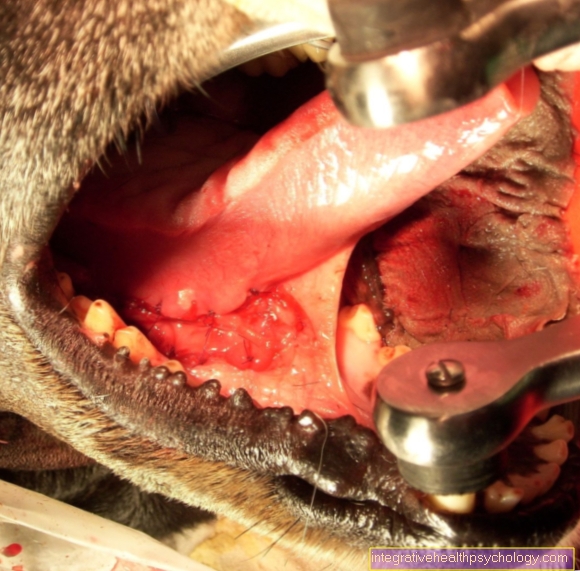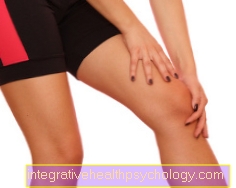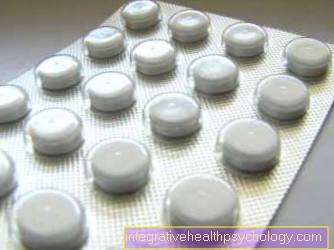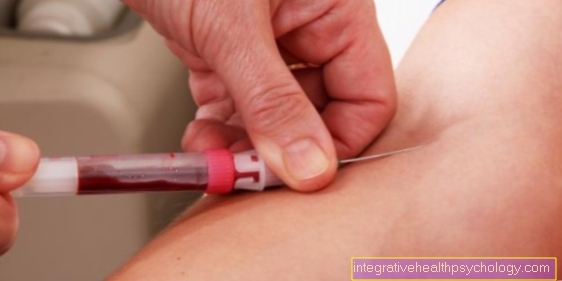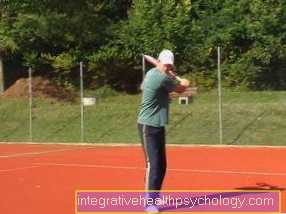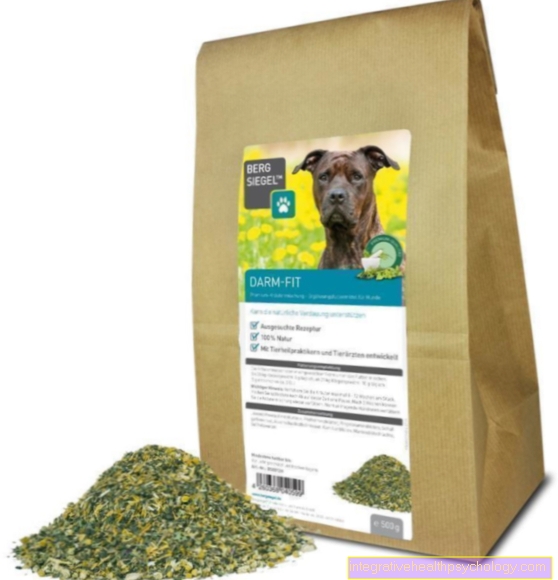Varicose veins in pregnancy
definition
Varicose veins (varices) are enlarged, superficial veins that are mostly visible under the skin in a curled shape. Most often the legs are affected by this phenomenon. In the long term, chronic venous weakness with an increased risk of thrombosis can occur. Pregnancy is a risk factor for the development or worsening of an already existing varicose vein condition.
You might also be interested in: Edema in pregnancy

Causes of varicose veins in pregnancy
The blood from the legs is pumped into the deep veins via the superficial ones, and from there back to the heart. In order to be able to do this against gravity, the muscles are used as a pump, among other things.
Furthermore, the veins have valves so that the blood cannot flow back. If these valves are defective, the blood can accumulate, especially in the superficial veins. Varices develop. Another reason for excessive venous filling can be an obstruction to outflow, e.g. as a result of a leg vein thrombosis. If the venous drainage system is disturbed, the blood collects in the superficial veins and the vessels expand like a sac. This is then visible in the form of varicose veins under the skin.
Factors favoring the formation of varices are weak connective tissue or an increase in pressure in the venous system.
The risk factors include:
- a family history,
- Overweight,
- predominantly sitting or standing activities,
- the female gender
- and pregnancy.
Existing varicose veins can intensify or appear for the first time, especially during pregnancy. Due to the pregnancy hormone progesterone, the connective and muscle tissue in the body loosens. This also causes the leg veins to become slack. If there is weak connective tissue, the wall of the veins slackens. The increased venous filling causes the veins to deform and become visible. Since the uterus enlarges during pregnancy, the venous return to the heart is made more difficult.
Diagnosis of varicose veins during pregnancy
The method of first choice to determine a venous function problem is so-called duplex sonography. This is an ultrasound examination in which the blood flow in the vascular system can be displayed in color and analyzed.
Read more on the topic: Doppler sonography
The permeability of the deep leg veins and the functionality of the superficial veins and their connecting veins are assessed. The vein function tests that were often carried out in the past have lost their importance due to this simple and informative method, but are still well suited for an initial assessment.
Accompanying symptoms of varicose veins during pregnancy
With varicose veins (varicosis), a feeling of heaviness in the legs may initially appear.Pain, itching and a feeling of tension in the area of the varicose veins are accompanying symptoms.
It can also lead to discomfort and leg cramps. After a long day, the ankles can become thick and retain water (edema).
Symptoms typically get worse when the heat is on and the legs get better when the legs are raised. If the venous weakness persists for a very long time, metabolic products of the blood can pass through the vessel wall into the tissue. Iron deposits in the skin are particularly noticeable in the form of dark spots. After a while, the skin can become inflamed. It becomes red, tense, and scaly. If a varicosis remains untreated for a long time, it can lead to sores of the skin with open wounds, the so-called ulcers.
Varicose vein pain during pregnancy
Varicose veins can become very painful, especially after long periods of standing or heat. Elevating and cooling the legs can help. If the pain worsens, a doctor should be consulted. Reasons for severe pain can include bleeding, inflammation of the varicose veins, substance defects in the lower leg or deep vein thrombosis.
Treatment of varicose veins during pregnancy
The options for treating varicose veins depend on the type and stage of the disease. Both conservative and surgical therapies are available.
Basically, a healthy lifestyle, no smoking and weight control have a positive effect on the disease. A lot of sport and exercise strengthens the muscles and thus promotes the removal of blood from the legs through the muscle pump function.
Cold baths according to Kneipp are also useful, as the veins contract when it is cold.
The medicinal plants used, which contract the vessel walls, include:
- Horse chestnut extracts,
- Red vine leaves
- and butcher's broom root.
Furthermore, therapy with compression stockings can prevent the occurrence of accompanying symptoms. In the case of edema, decongestion therapy or manual lymph drainage can help.
In the case of small-caliber varices, the spider veins, a so-called sclerotherapy can be performed. A substance is injected into the varicose vein, which closes it and thus makes it impermeable to the backed-up blood. Surgery can also be considered in the case of severe complaints, frequent complications or for cosmetic reasons. With vein stripping, the diseased part of the vein is removed. In addition, the connection between the superficial and deep veins at the level of the groin can be severed, which is known as a crossectomy.
Read more on the topic: Remove varicose veins
Duration
Varicose veins during pregnancy can regress after the birth with normalization of the hormonal balance. However, this can take up to a year. Varicose veins can also become chronic and should therefore be treated early.
Varicose veins in the genital area during pregnancy
During pregnancy, the evacuation of the venous blood is more difficult due to an increase in pressure and resistance, among other things by the growing child. This can lead to the congestion of smaller veins, which can also become noticeable in the genital area as varicose veins. Possible locations are the vagina (vulvar varices) and labia. There they are often accompanied by a feeling of pressure, swelling and pain. Radiation into the lower abdomen, discomfort when urinating or during sexual intercourse is also possible.
If the varicose veins appear during pregnancy, they usually regress on their own after the birth. If there is a general venous disease, the cause should be sought. If the varicose veins persist and represent a purely cosmetic problem, they can become deserted and are usually no longer visible.
Homeopathy for varicose veins during pregnancy
The single remedy homeopathy according to Samuel Hahnemann contains therapeutic approaches for varicose veins. Examples of therapeutic agents are Hamamelis and Lachesis, which are used for congested, touch-sensitive and painful veins. Pulsatilla and Millefolium are used especially during pregnancy to treat swollen, heavy legs. Complex agents with a combination of individual active ingredients are also available. These include the Heweven complex or the Ho-Fu complex.
A medical consultation is always useful. If the symptoms get worse or signs of inflammation, a doctor should be consulted.
Please also read: Homeopathy for varicose veins
How high is the risk of thrombosis?
The development of a deep vein thrombosis is favored by a reduced flow velocity of the venous blood. In addition, when varicose veins become inflamed, there is a risk of ingrowth into the deep leg vein system, which also increases the risk of thrombosis. Inflammation shows up as painful reddening, overheating and swelling of the affected area.
Symptoms of deep vein thrombosis include a swollen, painful, and bluish leg. This can also be overheated and stretched. A doctor should treat thrombosis immediately. Wearing support stockings improves venous return and reduces the risk of developing leg vein thrombosis.
Read more on the subject at: Thrombosis in Pregnancy

